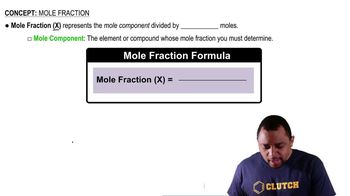At 63.5 °C, the vapor pressure of H2O is 175 torr, and that of ethanol (C2H5OH) is 400 torr. A solution is made by mixing equal masses of H2O and C2H5OH. (a) What is the mole fraction of ethanol in the solution?
Ch.13 - Properties of Solutions
Chapter 13, Problem 70a
At 20 °C, the vapor pressure of benzene (C6H6) is 75 torr, and that of toluene (C7H8) is 22 torr. Assume that benzene and toluene form an ideal solution. (a) What is the composition in mole fraction of a solution that has a vapor pressure of 35 torr at 20 °C?
 Verified step by step guidance
Verified step by step guidance1
Start by understanding Raoult's Law, which states that the vapor pressure of an ideal solution is the sum of the partial pressures of its components. The partial pressure of each component is the product of its mole fraction in the solution and its vapor pressure as a pure substance.
Let xbenzene be the mole fraction of benzene and xtoluene be the mole fraction of toluene. Since these are the only two components in the solution, their mole fractions must add up to 1: xbenzene + xtoluene = 1.
According to Raoult's Law, the total vapor pressure (Ptotal) of the solution is given by: Ptotal = xbenzene * Pbenzene + xtoluene * Ptoluene, where Pbenzene = 75 torr and Ptoluene = 22 torr.
Substitute the given total vapor pressure (35 torr) into the equation: 35 = xbenzene * 75 + xtoluene * 22.
Use the equation xbenzene + xtoluene = 1 to express xtoluene in terms of xbenzene (xtoluene = 1 - xbenzene) and substitute it into the vapor pressure equation to solve for xbenzene. Once you have xbenzene, you can find xtoluene.

Verified video answer for a similar problem:
This video solution was recommended by our tutors as helpful for the problem above.
Video duration:
6mWas this helpful?
Key Concepts
Here are the essential concepts you must grasp in order to answer the question correctly.
Vapor Pressure
Vapor pressure is the pressure exerted by a vapor in equilibrium with its liquid or solid phase at a given temperature. It reflects the tendency of particles to escape from the liquid phase into the vapor phase. In this context, the vapor pressures of benzene and toluene indicate how readily each substance evaporates, which is crucial for determining the composition of the solution at a specific vapor pressure.
Recommended video:
Guided course

Raoult's Law and Vapor Pressure
Raoult's Law
Raoult's Law states that the vapor pressure of a solvent in a solution is directly proportional to the mole fraction of the solvent in the solution. For an ideal solution, the total vapor pressure is the sum of the partial pressures of each component, calculated using their respective mole fractions and pure component vapor pressures. This law is essential for solving the problem, as it allows us to relate the vapor pressure of the solution to its composition.
Recommended video:
Guided course

Raoult's Law and Vapor Pressure
Mole Fraction
Mole fraction is a way of expressing the concentration of a component in a mixture, defined as the ratio of the number of moles of that component to the total number of moles of all components in the mixture. In this question, calculating the mole fractions of benzene and toluene will help determine the composition of the solution that results in a specific vapor pressure, which is key to finding the answer.
Recommended video:
Guided course

Mole Fraction Formula
Related Practice
Textbook Question
Textbook Question
At 63.5 °C, the vapor pressure of H2O is 175 torr, and that of ethanol (C2H5OH) is 400 torr. A solution is made by mixing equal masses of H2O and C2H5OH. (b) Assuming ideal solution behavior, what is the vapor pressure of the solution at 63.5 °C?
Textbook Question
At 20 °C, the vapor pressure of benzene (C6H6) is 75 torr, and that of toluene (C7H8) is 22 torr. Assume that benzene and toluene form an ideal solution. (b) What is the mole fraction of benzene in the vapor above the solution described in part (a)?
Textbook Question
List the following aqueous solutions in order of increasing boiling point: 0.120 m glucose, 0.050 m LiBr, 0.050 m Zn(NO3)2.
